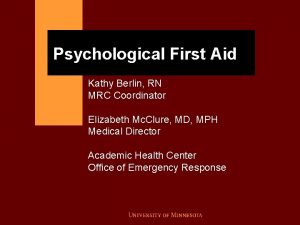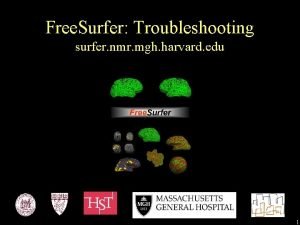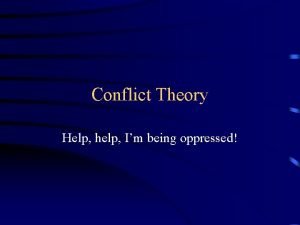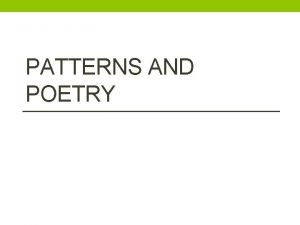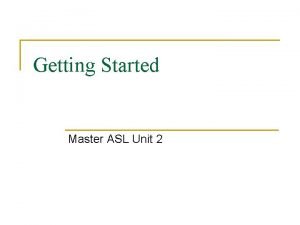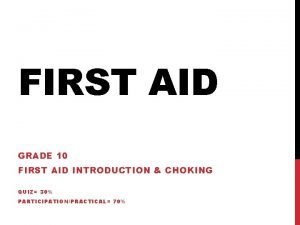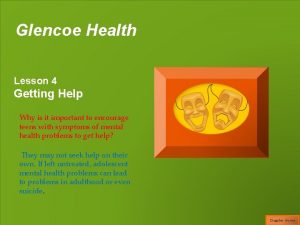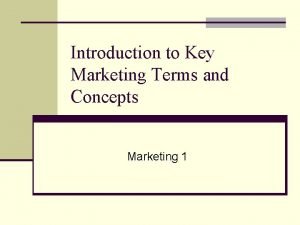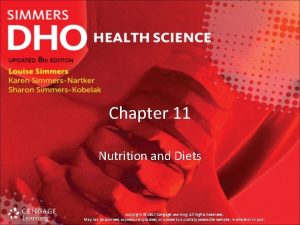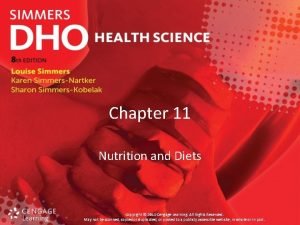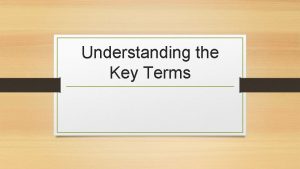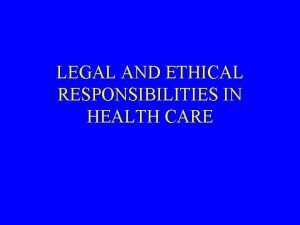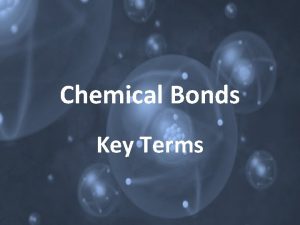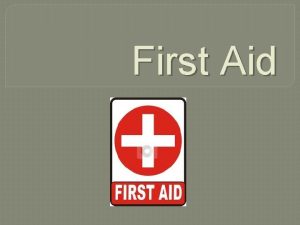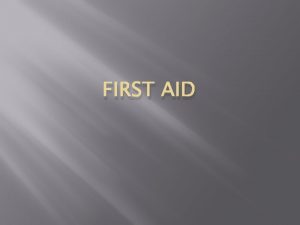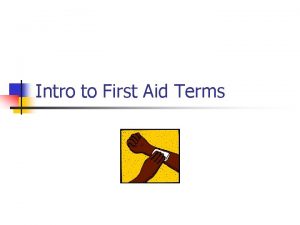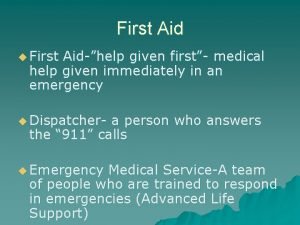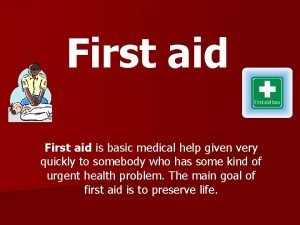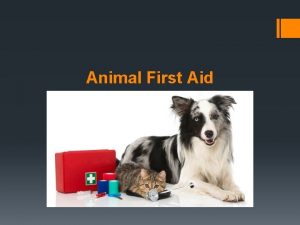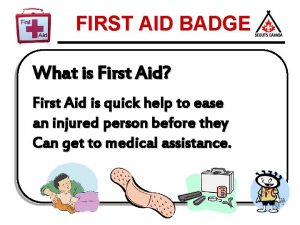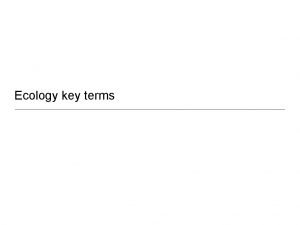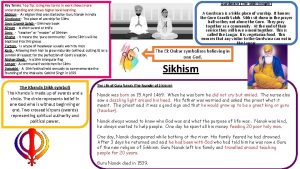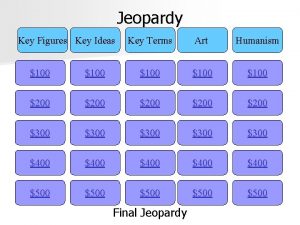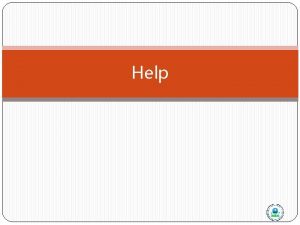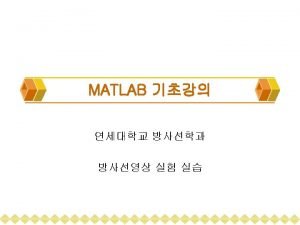First Aid Key Terms First Aid help given
































- Slides: 32

First Aid

Key Terms • First Aid - help given to a sick or injured person until full medical treatment is available. • Splinting - is a piece of medical equipment used to keep an injured body part from moving and to protect it from any further damage. • Heat Injury - a condition marked by fever and often by unconsciousness, caused by failure of the body's temperature-regulating mechanism when exposed to excessively high temperatures.

Key Terms (Cont. ) • Casualty - a person badly affected physically or mentally by an event or situation • Burns - an injury caused by exposure to heat or flame. • Fracture - break or cause to break, open or close. • Poison - Any substance that can cause severe organ damage or death if ingested, breathed in, or absorbed through the skin.

Key Terms (Cont. ) • Cuts - Severed skin. Washing a cut or scrape with soap and water to clean and dry and applying a band aid is all that is required to care for most small cuts.

What is the purpose of First Aid • The purpose of first aid is to minimize injury and future disability. In serious cases, First Aid may be necessary to keep the victim alive.

The objectives of First Aid • To stop the bleeding • Overcome shock • Relieve pain • Prevent infection

Splinting - is a piece of medical equipment used to keep an injured body part from moving and to protect it from any further damage.

How To Treat Splinting

Heat Injuries • Heat Injury - a condition marked by fever and often by unconsciousness, caused by failure of the body's temperature-regulating mechanism when exposed to excessively high temperatures. • There are 3 types of heat injuries –Heat Cramps –Heat Exhaustion –Heat Stroke

Heat Injuries • Heat injuries result primarily from excessive loss of salt from the body. This condition occurs when individuals who have been actively sweating don`t replace the salt loss in their sweat.

Heat Injury Symptoms • Painful contractions of muscles (normally the extremities and abdominal muscles). Body temperatures is normal unless heat cramps are accompanied by heat exhaustion.

Fractures • Fracture - break or cause to break, open or close.

Fractures • There are two types of basic fractures –The first is the open fracture (compound) –The second is the closed fracture (simple)

How to treat fractures • A fracture often requires emergency treatment at a hospital. An example of a minor fracture that may not require emergency care is a fracture of the tip of a toe. If you think that bones may be broken in the back, neck, or hip, do not move the person and call 911.

Stop and do Worksheet 1

Burns • Burns - an injury caused by exposure to heat or flame.

Types of Burns • First Degree Burn - is superficial and causes local inflammation of the skin. Sunburns often are categorized as first degree burns. The inflammation is characterized by pain, redness, and a mild amount of swelling. The skin may be very tender to touch. • Second degree burns - are deeper and in addition to the pain, redness and inflammation, there is also blistering of the skin. • Third degree burns are deeper still, involving all layers of the skin, in effect killing that area of skin. Because the nerves and blood vessels are damaged, third degree burns appear white and leathery and tend to be relatively painless.

Burns Treatments • Minor burns will heal over time and usually home treatment is all you need • If you have a more than a minor burn get first aid treatment and get a doctor

Casualty • Casualty - a person badly affected physically or mentally by an event or situation

Causes of Casualty • It could be any type of injury from anywhere • A casualty may or may not show signs and/or symptoms of an injury. • Before treating a casualty, ensure YOUR safety first! • Notify or tell another person to notify medical professionals as you give care. • If you do not know how to administer care, do not guess on what to do. Get help!

Treatment of a casualty • Step 1: Check for responsiveness • Step 2: Check for any type of injury that they might have • Step 3: Get help

Stop and do worksheet 2

Poison • Poison - Any substance that can cause severe organ damage or death if ingested, breathed in, or absorbed through the skin.

Causes of Poison • You get poisoned from substances like plants or chemicals getting into your body through various methods.

Treatment of Poison • Usually it depends on what plant or a chemical that you have on your skin or inside your body. • Poison requires immediate professional medical attention! Do not wait. Contact poison control and seek help as soon as possible.

Cuts • Cuts - Severed skin. Washing a cut or scrape with soap and water to clean and dry and applying a band aid is all that is required to care for most small cuts.

Causes of Cuts • Cuts can be caused by something sharp such as paper, scissors, thorns, etc.

Treatment of Cuts • Usually most cuts are minor and can be treated with a band aid or something to cover it temporarily • Cleanliness = the greatest preventative measure for disease!

Three Types of Bleeding 1. Arterial- Blood is bright red and will spurt with each heartbeat 2. Venous- Blood is dark red and flows in a steady stream 3. Capillary- Blood oozes from the wound

Stop and do worksheet 3

Do you have any questions?

Review what you went over and take the test
 First aid merit badge first aid kit
First aid merit badge first aid kit Kathy berlin
Kathy berlin Help us help you
Help us help you I m being oppressed
I m being oppressed Help help chapter 1
Help help chapter 1 Education through self help is our motto
Education through self help is our motto Help us help you
Help us help you Easy asl sentences
Easy asl sentences Polynomial degrees and terms
Polynomial degrees and terms Identify like terms
Identify like terms Three ps in first aid
Three ps in first aid Business canvas example
Business canvas example Key partners key activities key resources
Key partners key activities key resources Neasden and greenhill medical centre
Neasden and greenhill medical centre Subdividing a segment
Subdividing a segment Chapter 5 mental and emotional problems lesson 2 answer key
Chapter 5 mental and emotional problems lesson 2 answer key Chapter 5 mental and emotional problems lesson 4 answer key
Chapter 5 mental and emotional problems lesson 4 answer key Chapter 5 section 4
Chapter 5 section 4 Post colonial theory
Post colonial theory Key marketing terms
Key marketing terms Test chapter 11 nutrition and diets
Test chapter 11 nutrition and diets Review exercise terms and events answer key
Review exercise terms and events answer key Reviewing key terms
Reviewing key terms Key terms in postcolonial theory
Key terms in postcolonial theory Geometry key terms
Geometry key terms Test chapter 11 nutrition and diets
Test chapter 11 nutrition and diets Define the following key terms
Define the following key terms Comprehensive strategic management model
Comprehensive strategic management model Behaviourist approach key terms
Behaviourist approach key terms Chapter 5 legal and ethical responsibilities key terms
Chapter 5 legal and ethical responsibilities key terms Key terms examples
Key terms examples Key terms for division
Key terms for division A compound that has water chemically attached to it
A compound that has water chemically attached to it

